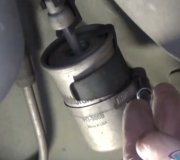First of all, the fuel pump should not be running by bypassing the inertia switch. That is a circuit breaker that is tripped by an impact to stop the pump if everything else fails. The pump also will not run unless the engine is rotating, (cranking or running). That is a safety requirement. If a fuel line is ruptured in a crash, the engine can't run without fuel pressure. When the engine stalls, no signals are received from the crankshaft position sensor or the camshaft position sensor. Loss of those signals tells the Engine Computer to turn the fuel pump relay off. That stops the flow of raw fuel onto the ground and prevents a fire hazard.
Normally we replace the complete pump assembly because we know it's assembled correctly and it costs our customers less money for labor. It sounds like you bought just the pump / motor that gets installed into the assembly. If that hose you're having trouble with is hard plastic and shiny, you most likely didn't find a hose clamp on the old one, and the parts guy is right about having to heat the new one. Don't get carried away with a torch. A few seconds with a hot air gun will soften it enough to become pliable so you can push it on.
Another thing to look for on Ford products are the hoses in that assembly. It is fairly common for them to dry-rot and allow air to be sucked up instead of fuel. The clue is the engine will run fine until the fuel level gets down to 1/4 tank.
There's two other things that I've done that you might consider. The first is when you replace just the pump, on most of them you can mix up the two wires. If you connect them backward, the pump will run just fine but it will be running backward and will try to push air into the tank. The second thing is switching two hoses to the tank. I managed to do this twice on my van, even though the metal pipes are different sizes. The symptom was the pump would run but there was no pressure at the engine.
If you have a leak in the metal pipe running under the car, that can be replaced with bulk rubber hose, but you have to use the more-expensive fuel injection hose. That costs about four bucks per foot. Regular fuel hose for carbureted cars won't withstand the pressure from a fuel injection pump.
Saturday, February 14th, 2015 AT 4:22 PM



